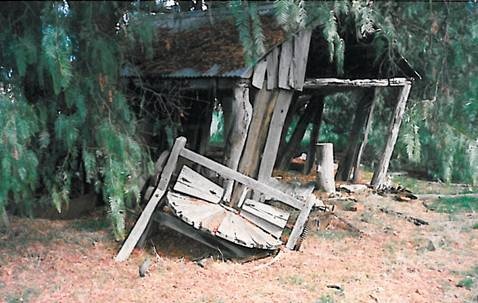Monmore Vineyard and Butter Factory
51 Bayliss Road, WOODVALE VIC 3556 - Property No 201428
-
Add to tour
You must log in to do that.
-
Share
-
Shortlist place
You must log in to do that.
- Download report




Statement of Significance
What is significant?
The early mud brick building (believed to be the former dairy 'cooling chamber') is extant and consists of a cooling chamber of mud brick construction with 60cm [2ft] thick ventilated walls, double doors, fireplace and chimney and loft space. The dairy is believed to have a hipped roof and evidence of white wash to the upper sections of the walls. The later dairy alongside is presumed to have been built during the interwar period and is of brick.
How is it significant?
The Monmore Vineyard and Butter Factory property is of local historical and technological significance.
Why is it significant?
The Monmore Vineyard and Butter Factory property is historically significant (Criterion A) for its capacity to recall aspects of the history of agriculture in Woodvale, including mixed farming, dairying and vineyards. Edward Bayliss, who had arrived from England in 1856, and established the farm in the 1870s, built up the property into a successful dairying and viticulture operation in the latter nineteenth century, producing his own brand of 'Monmore' butter. The reputed construction of a two mile-long water race by Bayliss, to connect up with the Whipstick water race, also emphasises the difficulties experienced by early settlers in securing access to water and their resourcefulness in obtaining it. Technologically (Criterion F), the early mud brick dairy building (possibly the 'cooling chamber') is of significance as an early surviving example of a mud brick structure in the Bendigo region, representing a type of vernacular construction which was once more common in the area. The cooling chamber was built with particularly thick walls (c. 60cm), to provide an insulated and cool temperature environment for the storage of dairy products, including butter.
-
-
Monmore Vineyard and Butter Factory - Physical Description 1
The focus of this citation is on the early mud brick building (believed to be the former 'cooling chamber' and perhaps the earliest house on the site). The condition in November 2011 indicates that the building is in a poor structural state, subject to water damage. There are large structural cracks throughout. Sections of the rear external wall which contained an external window has collapsed and some internal walls have also collapsed. The upper timber loft area is in a poor condition and in need of stabilisation.11
The former Monmore vineyard and dairy is a complex of ruinous buildings and machinery including the former farmhouse and associated kitchen, now demolished, two dairies of varying dates, a wine cellar, filled in, and blacksmith's shed. Many of the moveable items, machinery and outbuildings are no longer on site. A photographic record of all items was completed by Robyn Ballinger in 2005 as a condition of the demolition permit for the timber house.12 The timber-framed house was demolished in 2005. It had a gable roof with fretted barges and a projecting wing, presenting with an asymmetrical aspect to the roadway. The three rooms and a vestibule connecting with the collapsed mud brick kitchen wing have all been demolished. The earliest dairy is of mud brick construction with 60cm [2ft] thick ventilated walls, double doors, fireplace and chimney [Note: This may be the 'cooling chamber' referred to in the 'History' and is still extant. 13The dairy had a hipped roof and evidence of white wash to the upper sections of the walls. The later brick dairy, alongside is presumed to have been built during the interwar period and is of red brick. The winery is ruinous and consists of a cellar , now filled in, which was surmounted by a former Railway Department gatekeeper's cottage ('no.7'), now demolished. This was a small timber lined building with coved ceilings and has the number 7 in faded paint on the gable end. The smithy's is a bush pole shed with vertical slabs, riveted iron forge, metal implements and anvil base and is extant. There are large extant machinery sheds nearby in bush pole and part mud brick and timber construction. Machinery that was recorded on site in 1993 within the vicinity of the buildings included a steam driven butter churn and there was at least one line of cable and posts with remnants of the grape vines. These have now largely been removed from site14
Heritage Study and Grading
Greater Bendigo - Heritage Policy Citations Review
Author: Lovell Chen P/L
Year: 2011
Grading: Local
-
-
-
-
-
Monmore Vineyard and Butter Factory
 Greater Bendigo City
Greater Bendigo City
-
'Boonderoo', House and Outbuildings
 Greater Bendigo City
Greater Bendigo City -
'Riverslea' house
 Greater Bendigo City
Greater Bendigo City -
1 Adam Street
 Yarra City
Yarra City
-
-










